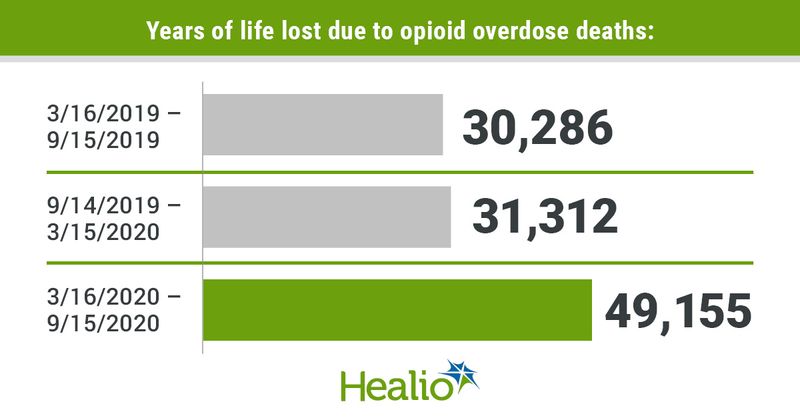Opioid overdose deaths increased in Ontario during pandemic
The U.S. is not the only country experiencing a rise in opioid-related deaths in the era of COVID-19.
A Canadian study found that opioid-related deaths increased in Ontario from 766 in the 6 months before the pandemic to 1,237 from March 2020 to September 2020.

“Pandemic-mandated measures, including changes to health care delivery to accommodate physical distancing and increased social isolation, can increase the risk of harm for people who use drugs,” Tara Gomes, PhD, MHSc, an epidemiologist, principal investigator at the Ontario Drug Policy Research Network and a scientist at Li Ka Shing Knowledge Institute at St. Michael’s Hospital in Toronto, Ontario, and colleagues wrote. “For example, reduced operation hours of health care services (eg, pharmacies and outpatient clinics) and harm reduction services (eg, drug checking programs and supervised consumption sites) have introduced additional barriers to care for people with opioid use disorder.”
Gomes and colleagues conducted a cross-sectional study to assess weekly fatal opioid overdoses that occurred in Ontario among people aged 15 years or older from January 1, 2018, to September 20, 2020. The researchers compared fatal overdose rates and characteristics that occurred in the first 6 months after a state of emergency was declared — from March 16, 2020, to September 15, 2020 — with the same period the previous year, as well as the 6 months prior to COVID-19, from September 14, 2019, to March 15, 2020.
In the period between March 16, 2020, to September 15, 2020, 1,237 people died of opioid-related causes, totaling 49,155 years of life lost. In contrast, there were 766 opioid-related deaths in the same period in the year before, representing 30,286 years of life lost, and 771 deaths in the previous 6 months, representing 31,312 years of life lost.
In addition, fentanyl (1,056 vs. 586; P < .001) and stimulants (880 vs. 485; P < .001) were detected more often among people who died from opioid overdoses after the state of emergency was declared vs. the 6 months immediately before, according to Gomes and colleagues.
Overall, the weekly number of opioid-related deaths increased by 135%, with 2,774 people (73.4% men; aged 35 to 54 years, 47.2%) dying from an opioid-related cause over all three periods of interest. Weekly deaths among people aged under 35 years increased by 320%, representing the greatest increase. Conversely, in the U.S., Healio previously reported that adults aged 35 to 44 years appeared to have a greater risk for overdose.
“The rising rates of harm among young adults as well as the increased contributions of fentanyl and stimulants to these deaths emphasize the urgent need for low-barrier access to evidence-based harm reduction services and treatment for opioid use disorder in all jurisdictions grappling with the overdose–COVID-19 syndemic,” the researchers wrote.
In a commentary published in The Lancet, Richard Horton, FRCP, FRCPCH, FMedSci, the journal’s editor-in-chief, explained that syndemics are characterized “by biological and social interactions between conditions and states, interactions that increase a person’s susceptibility to harm or worsen their health outcomes.”
The term originated with medical anthropologist Merrill Singer, PhD, who posited that studying phenomena through this lens “reveals biological and social interactions that are important for prognosis, treatment, and health policy,” Horton wrote.
In the case of COVID-19, previous research has revealed racial disparities in COVID-19 diagnoses and hospitalizations, including in pediatric populations, and cardiovascular disease complications, among other inequities. Experts said that COVID-19 has exacerbated existing health disparities that are caused by structural racism, and that these disparities must be addressed.
References:
- Gomes T, et al. JAMA Netw Open. 2021;doi:10.1001/jamanetworkopen.2021.12865.
- Horton R. Lancet. 2021;doi:10.1016/S0140-6736(20)32000-6.

